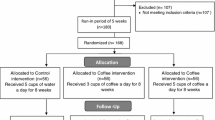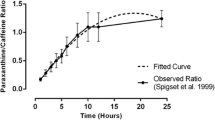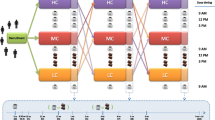Abstract
Objectives
To investigate the influence of coffee consumption on CYP1A2 enzyme activity controlling for the effects of smoking and oral contraceptive (OC) use among Serbs and Swedes and to compare CYP1A2 activity between the two populations.
Methods
Data on oral contraceptive use, habitual coffee consumption and smoking habits were obtained from 100 Serbian and 149 Swedish healthy volunteers using a detailed questionnaire. CYP1A2 activity was estimated by plasma paraxanthine/caffeine (17X/137X) ratio analysed by reversed-phase HPLC after oral administration of 100 mg caffeine.
Results
Daily consumption of at least three cups of coffee significantly increased CYP1A2 enzyme activity in both Serbs (P = 0.0002) and Swedes (P < 0.0001). Among non-smokers and non-OC users, heavy coffee consumption significantly increased CYP1A2 activity in Serbs (mean difference 0.11; 95% CI of the mean difference 0.04, 0.18; P = 0.003) and Swedes (mean difference 0.07; 95% CI of the mean difference 0.01, 0.12; P = 0.02). Significantly higher 17X/137X ratio was detected in Serbian smokers compared to non-smokers. There was no significant gender difference in CYP1A2 activity in Serbs. Controlling for the effect of smoking, heavy coffee consumption habit and oral contraceptive use, significantly lower 17X/137X ratio was observed in Serbs than in Swedes (P = 0.0003).
Conclusions
Habitual heavy coffee consumption increases CYP1A2 activity. Polycyclic aromatic hydrocarbons formed during roasting of coffee beans might partly be responsible for this effect. The reason for the observed lower CYP1A2 activity in Serbs as compared to Swedes remains to be investigated.

Similar content being viewed by others
References
Ma X, Idle JR, Krausz KW, Gonzalez FJ (2005) Metabolism of melatonin by human cytochromes p450. Drug Metab Dispos 33(4):489–494
Eaton DL, Gallagher EP, Bammler TK, Kunze KL (1995) Role of cytochrome P4501A2 in chemical carcinogenesis: implications for human variability in expression and enzyme activity. Pharmacogenetics 5(5):259–274
Bertilsson L, Dahl M, Ingelman-Sundberg M, Johansson I, Sjöqvist F (1995) Inter-individual and inter-ethnic differences in polymorphic drug oxydation. In: Pacifici G, Fracchia G (eds) Advances in drug metabolism in man. European Commission, Bruxelles, pp 86–136
Tassaneeyakul W, Birkett DJ, McManus ME, Tassaneeyakul W, Veronese ME, Andersson T, Tukey RH, Miners JO (1994) Caffeine metabolism by human hepatic cytochromes P450: contributions of 1A2, 2E1 and 3A isoforms. Biochem Pharmacol 47(10):1767–1776
Carrillo JA, Christensen M, Ramos SI, Alm C, Dahl ML, Benitez J, Bertilsson L (2000) Evaluation of caffeine as an in vivo probe for CYP1A2 using measurements in plasma, saliva, and urine. Ther Drug Monit 22(4):409–417
Aklillu E, Carrillo JA, Makonnen E, Hellman K, Pitarque M, Bertilsson L, Ingelman-Sundberg M (2003) Genetic polymorphism of CYP1A2 in Ethiopians affecting induction and expression: characterization of novel haplotypes with single-nucleotide polymorphisms in intron 1. Mol Pharmacol 64(3):659–669
Fontana RJ, Lown KS, Paine MF, Fortlage L, Santella RM, Felton JS, Knize MG, Greenberg A, Watkins PB (1999) Effects of a chargrilled meat diet on expression of CYP3A, CYP1A, and P-glycoprotein levels in healthy volunteers. Gastroenterology 117(1):89–98
Zhou H, Josephy PD, Kim D, Guengerich FP (2004) Functional characterization of four allelic variants of human cytochrome P450 1A2. Arch Biochem Biophys 422(1):23–30
Kalow W, Tang BK (1991) Caffeine as a metabolic probe: exploration of the enzyme-inducing effect of cigarette smoking. Clin Pharmacol Ther 49(1):44–48
Han XM, Ouyang DS, Chen XP, Shu Y, Jiang CH, Tan ZR, Zhou HH (2002) Inducibility of CYP1A2 by omeprazole in vivo related to the genetic polymorphism of CYP1A2. Br J Clin Pharmacol 54(5):540–543
Parker AC, Pritchard P, Preston T, Choonara I (1998) Induction of CYP1A2 activity by carbamazepine in children using the caffeine breath test. Br J Clin Pharmacol 45(2):176–178
Rasmussen BB, Maenpaa J, Pelkonen O, Loft S, Poulsen HE, Lykkesfeldt J, Brosen K (1995) Selective serotonin reuptake inhibitors and theophylline metabolism in human liver microsomes: potent inhibition by fluvoxamine. Br J Clin Pharmacol 39(2):151–159
Ghotbi R, Christensen M, Roh HK, Ingelman-Sundberg M, Aklillu E, Bertilsson L (2007) Comparisons of CYP1A2 genetic polymorphisms, enzyme activity and the genotype-phenotype relationship in Swedes and Koreans. Eur J Clin Pharmacol 63(6):537–546
Kalow W, Tang BK (1991) Use of caffeine metabolite ratios to explore CYP1A2 and xanthine oxidase activities. Clin Pharmacol Ther 50(5 Pt 1):508–519
Tantcheva-Poor I, Zaigler M, Rietbrock S, Fuhr U (1999) Estimation of cytochrome P-450 CYP1A2 activity in 863 healthy Caucasians using a saliva-based caffeine test. Pharmacogenetics 9(2):131–144
Relling MV, Lin JS, Ayers GD, Evans WE (1992) Racial and gender differences in N-acetyltransferase, xanthine oxidase, and CYP1A2 activities. Clin Pharmacol Ther 52(6):643–658
Masimirembwa CM, Beke M, Hasler JA, Tang BK, Kalow W (1995) Low CYP1A2 activity in rural Shona children of Zimbabwe. Clin Pharmacol Ther 57(1):25–31
Okey AB (1990) Enzyme induction in the cytochrome P-450 system. Pharmacol Ther 45(2):241–298
Ayalogu EO, Snelling J, Lewis DF, Talwar S, Clifford MN, Ioannides C (1995) Induction of hepatic CYP1A2 by the oral administration of caffeine to rats: lack of association with the Ah locus. Biochim Biophys Acta 1272(2):89–94
Horn EP, Tucker MA, Lambert G, Silverman D, Zametkin D, Sinha R, Hartge T, Landi MT, Caporaso NE (1995) A study of gender-based cytochrome P4501A2 variability: a possible mechanism for the male excess of bladder cancer. Cancer Epidemiol Biomarkers Prev 4(5):529–533
Landi MT, Zocchetti C, Bernucci I, Kadlubar FF, Tannenbaum S, Skipper P, Bartsch H, Malaveille C, Shields P, Caporaso NE, Vineis P (1996) Cytochrome P4501A2: enzyme induction and genetic control in determining 4-aminobiphenyl-hemoglobin adduct levels. Cancer Epidemiol Biomarkers Prev 5(9):693–698
Le Marchand L, Franke AA, Custer L, Wilkens LR, Cooney RV (1997) Lifestyle and nutritional correlates of cytochrome CYP1A2 activity: inverse associations with plasma lutein and alpha-tocopherol. Pharmacogenetics 7(1):11–19
IARC Working Group on the Evaluation of Carcinogenic Risks to Humans (1991) Coffee, tea, mate, methylxanthines and methylglyoxal. IARC Monogr Eval Carcinog Risks Hum 51:1–513
Albertini S, Friederich U, Schlatter C, Wurgler FE (1985) The influence of roasting procedure on the formation of mutagenic compounds in coffee. Food Chem Toxicol 23(6):593–597
Del Bubba M, Zanieri L, Galvan P, Donzelli GP, Checchini L, Lepri L (2005) Determination of polycyclic aromatic hydrocarbons (PAHs) and total fats in human milk. Ann Chim 95(9–10):629–641
Houessou JK, Benac C, Delteil C, Camel V (2005) Determination of polycyclic aromatic hydrocarbons in coffee brew using solid-phase extraction. J Agric Food Chem 53(4):871–879
Chen ML (2006) Ethnic or racial differences revisited: impact of dosage regimen and dosage form on pharmacokinetics and pharmacodynamics. Clin Pharmacokinet 45(10):957–964
Acknowledgements
Authors would like to thank all volunteers who participated in the study; Ksenia Goryachkina, Sarah Nanzigu and Dejan Simic for providing blank plasma samples; and Jolanta Widen, Dragana Nedovic and Sladjana Petrovic for their technical assistance. The study was financially supported by the Swedish Research Council, Medicine, 3902, the Ministry of Science, Republic of Serbia, 145005 and the Swedish Institute, Stockholm, Sweden.
Conflict of interest statement
Authors have identified no conflict of interest in relation to this manuscript.
Author information
Authors and Affiliations
Corresponding author
Rights and permissions
About this article
Cite this article
Djordjevic, N., Ghotbi, R., Bertilsson, L. et al. Induction of CYP1A2 by heavy coffee consumption in Serbs and Swedes. Eur J Clin Pharmacol 64, 381–385 (2008). https://doi.org/10.1007/s00228-007-0438-6
Received:
Accepted:
Published:
Issue Date:
DOI: https://doi.org/10.1007/s00228-007-0438-6




